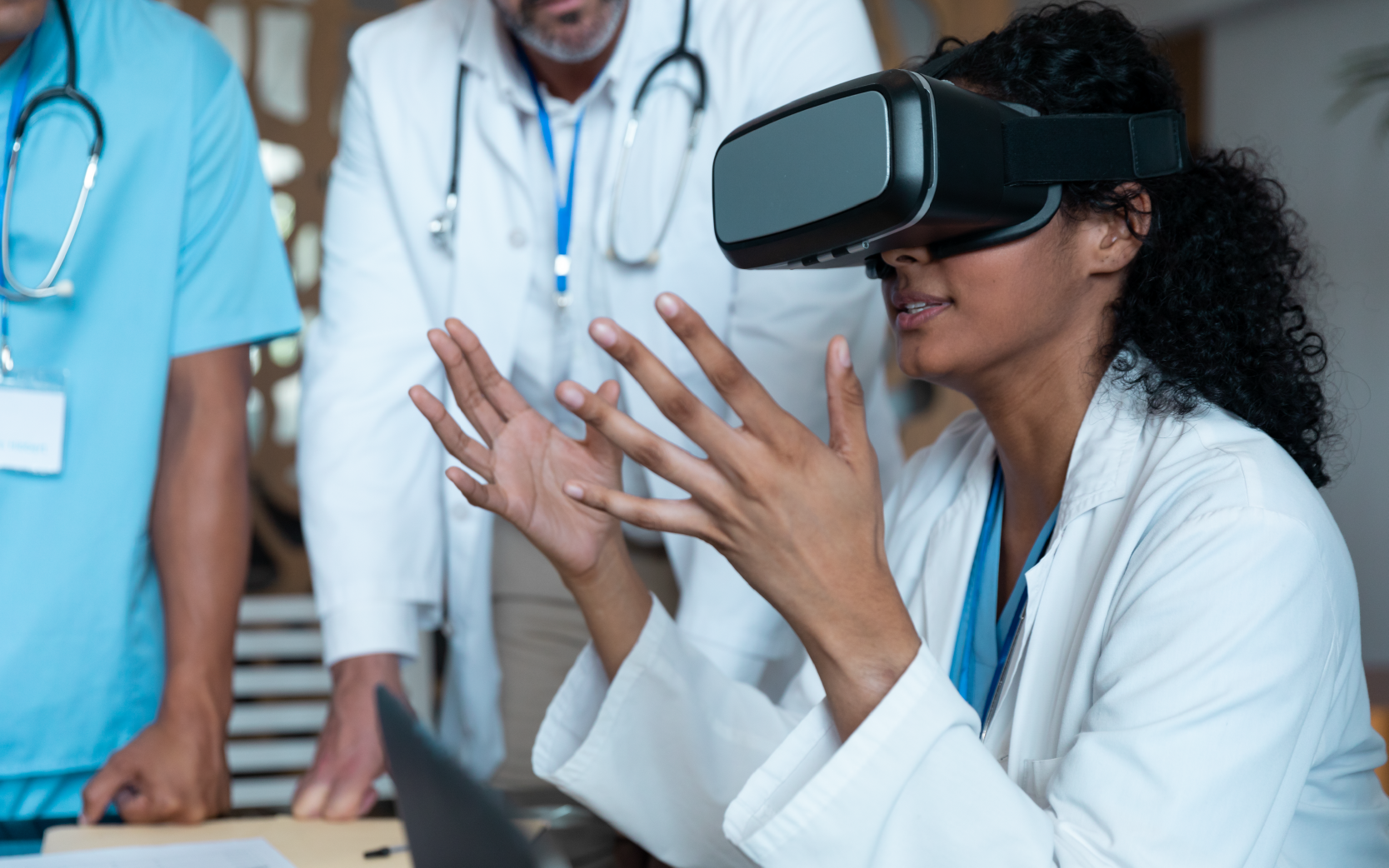In the age of advanced technology, virtual reality (VR) has become more than just a tool for entertainment–it is now an innovative means of education in healthcare settings. VR simulations offer a unique opportunity to practice clinical skills in a controlled, risk-free environment.
As with any technology, VR simulations come with limitations and lack the more nuanced, human-centric aspects crucial to nursing skill development.

For healthcare educators, it’s essential to strike a careful balance between educational tools and the realities of the human experience. Only a well-rounded simulation approach can prepare nurses for the complexities of real-world healthcare settings.
Benefits of VR Nursing Simulations
As VR nursing simulations grow in popularity, it’s easy to understand why. By leveraging modern technology, these programs can streamline parts of the learning process and reduce costs for the organization. Let’s take a closer look at the benefits.
Precision Practice in a Safe Environment
One of the clear advantages of VR nursing simulations is the ability to practice in a safe, highly controlled environment. Current VR platforms allow learners to perform complicated tasks, such as administering medications and conducting diagnostic tests, as if they were handling actual equipment and supplies. Learners can select and manipulate tools, adjust doses, and even experience tactile feedback.
By engaging in simulations, students can refine their technique and build muscle memory without the risk of harming patients. This method fosters a sense of confidence and readiness, which is invaluable in the early stages of clinical training.
Workflow and Protocol Immersion
One of the most challenging aspects of the job for novice nurses can be navigating the complex protocols that make up patient care. In VR simulations, learners can practice these workflows repeatedly, gaining an intimate understanding of the interactions and patterns of care delivery.
The available repetition of VR training helps students memorize protocols and safety measures. However, students can only prepare to handle unexpected situations calmly and efficiently by experiencing both typical and atypical scenarios.
Cost-Effective and Repeatable
Once a program acquires VR technology with an initial investment, the cost of training multiple students is minimal compared to the cost of consumables and equipment in a physical clinical setting for the same number of students.
Additionally, VR simulations are highly repeatable. Learners can return to specific scenarios for further practice without the constraints of time and resources that often limit the number of opportunities in traditional settings.
Simclusive’s standardized patients (SPs) also offer repeatability in clinical scenarios while providing something VR cannot. Virtual, on-demand sessions on our innovative platform provide ample opportunity to practice clinical skills while maintaining the variability of human nature, interpersonal interaction, and the patient-provider relationship.
No Risk to Patients
Students are bound to make mistakes. Errors are necessary in the learning process and encourage reflection, experimentation, and self-correction under the guidance of educators.
When practicing physical procedures or surgeries, learners cannot harm a virtual patient. This lack of risk to real-life humans allows students to learn from their mistakes without fear of causing harm.
Working with SPs can also mitigate the damage of mistakes made during learning, such as providing incorrect diagnoses or putting together an insufficient care plan.
Limitations of VR in Nursing Education
Despite the benefits of virtual reality nursing simulations, they simply can’t provide a comprehensive learning experience. Avatars naturally lack the human element crucial to holistic, inclusive patient care. Here are a few ways where this type of technology falls short.
The Art of Conversation and Comfort
Nursing is not just a series of technical processes; it’s also about seeing a patient as a whole person, building rapport, offering comfort, and engaging in genuine conversations with patients.
In self-assessed competencies, new graduate nurses expressed concern about their lack of soft skill competencies. While less tangible than hard skills, honing these soft skills is crucial for patient care as well as retention among graduate nurses.
While excellent for skill building, VR simulations cannot mimic the nuance of human interaction and communication. There are few opportunities to read body language and facial expressions or practice flexible communication skills that nurses need for effective patient care.
In VR simulations, conversations and scenarios are heavily scripted with little variability. However, at the bedside, patients may have communication challenges or be reluctant to share crucial information. Other patients may overshare, which can distract providers from relevant details. Only interactions and practice with actual people can mitigate the skill gap from VR simulations.
Limited Patient Presentation
Pre-programmed VR scenarios often represent a narrow slice of the patient population and their typical clinical presentation. Actual patients come from all backgrounds and represent all shapes, sizes, and temperaments. A cornerstone of nursing lies in adapting to individuals and their circumstances while remaining respectfully aware of personal and cultural differences.
VR simulations, as they stand, do not expose nurses to the full spectrum of patient experiences, potentially leading to a lack of preparedness for real-world patient care.
Simclusive supports its learners as they traverse exams and interviews with patients of diverse backgrounds while meeting learning objectives with our growing scenario library.
The Lost Human Element
Remembering the human element is critical in fostering genuine emotional buy-in from nursing students, allowing them to get the most out of the simulation.
While still a type of soft skill, this goes beyond applying the communication competencies we mentioned earlier. Rather, this element hinges on empathy, intuition, and the ability to connect with patients on a deeply personal level that cannot be replicated in VR, even with the most advanced technology.
The avatars used in VR simulation simply can’t express the pain and heartbreak of experiencing a miscarriage or receiving a cancer diagnosis. During these times, the nurse or care provider may be the only one there to provide comfort as the patient experiences the most devastating moments of their life.
VR simulations allow learners to dissociate from the virtual avatar and focus on the task at hand. But without human simulations to experience that human element firsthand, learners may find themselves wholly unprepared for the very real humans they will encounter on the job.
Diversity in Nursing Simulations
In the quest for inclusivity, VR nursing simulations are both a powerful ally and a potential stumbling block. While they have the potential to offer scenarios where culturally competent care can be practiced and learned, the reality is often quite different.
Reinforcing Stereotypes or Omitting Realities
The controlled nature of VR means that the creators define the parameters of the interaction. There is a real risk that uninformed scripted scenarios can reinforce stereotypes and ignore the perspectives and experiences of diverse patient populations. This omission could impact the care nursing students believe to be “standard” and reinforce implicit biases.
Even when simulations represent minority and marginalized groups, there are often severe limitations and missteps during production. For example, white voice actors frequently record over avatars of other ethnic and cultural groups. This practice renders the scenario inauthentic, is detrimental to learners, and is an injustice to the intended represented population.
No one can know a patient’s life better than themselves. Simclusive’s variety of SPs represent themselves and the complex stories of their authentic, lived experiences.
Lived Experience and Special Populations
To truly prepare students for the realities of modern healthcare practice, it’s critical to incorporate input from individuals who have walked different life paths. Educators and program developers must ensure that educational tools, like VR simulations and SPs, represent a range of voices and narratives that more accurately reflect the tapestry of real life.
Training for unique situations, like care for transgender patients, is rarely adequate in healthcare education, let alone accurately represented in VR training scenarios. The care a nurse provides to a patient will depend heavily on the particular circumstances of the patient and the nurse’s ability to suspend any underscoring bias or judgment. Without proper training and education, nurses will struggle to provide appropriate service to stigmatized and misunderstood patients.
The key to an effective nursing education is balance. VR should be considered a complementary tool, not an exclusive learning model. Nursing students cannot learn inclusive, patient-centered care solely through a screen. Programs can offer a comprehensive curriculum by balancing traditional clinical training, virtual reality drills, and standardized patient scenarios.
While much of the education world has been moved online in recent years, virtual healthcare training cannot afford to be any less substantial than traditional methods. Simclusive offers an inclusive selection of SP scenarios based on real humans of lived experience–all in a flexible, on-demand system well suited to busy students with rigorous learning objectives.

